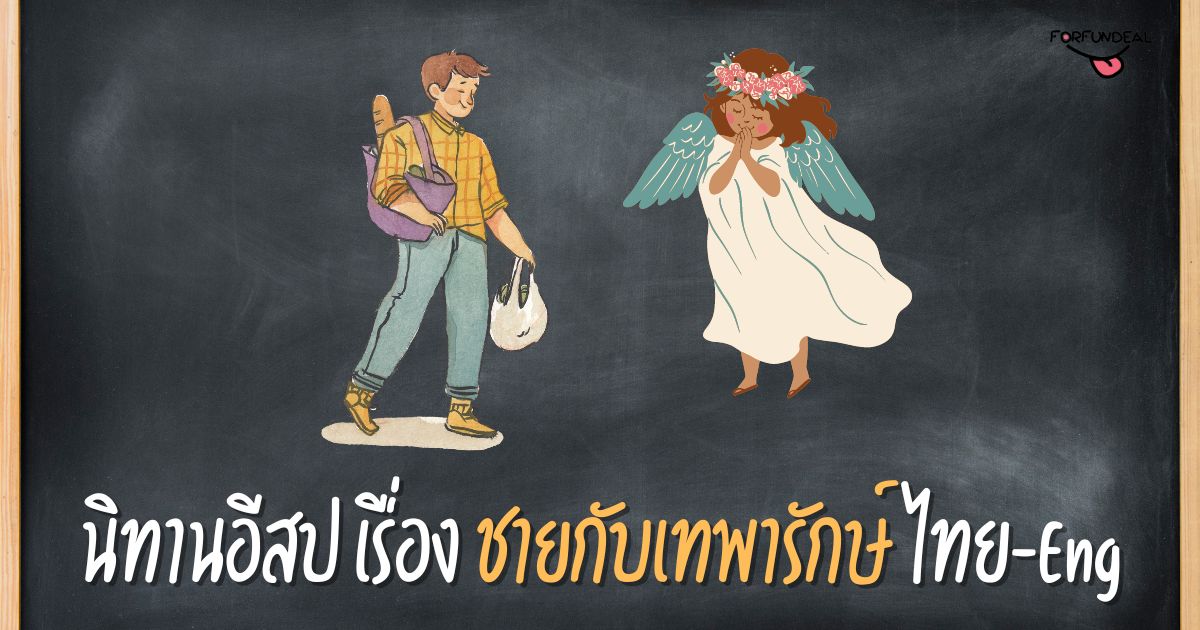“ชายหนุ่มกับเทพารักษ์” เป็นนิทานอีสปที่สอนเราถึงคุณค่าของสิ่งที่เรามีอยู่ และการโหยหากับสิ่งที่เราไม่ได้มี มันอาจอาจไม่ได้สวยงามเสมอ หรือเป็นที่ที่ของเราจริงๆ
นิทานอีสปเรื่องชายหนุ่มกับเทพารักษ์
กาลครั้งหนึ่งนานมาแล้ว ชายคนหนึ่งที่อาศัยอยู่ในเมืองตัดสินใจหลีกหนีเสียงอึกทึกและความวุ่นวายของชีวิตในเมืองและแสวงหาความสบายใจในธรรมชาติ เขาเข้าไปในป่าและได้พบกับเทพารักษ์ซึ่งเป็นสัตว์ในตำนานที่มีครึ่งคนครึ่งแพะ เทพารักษ์กำลังเสวยวิมุตติสุขในป่า
Once upon a time, a man who lived in the city decided to escape the noise and chaos of urban life and seek solace in nature. He ventured into the forest and came across a satyr, a mythical creature that was half-man and half-goat. The satyr was enjoying the peace and tranquility of the woods.
ชายคนนั้นเริ่มพูดคุยกับเทพารักษ์และแสดงความชื่นชมต่อชีวิตที่เรียบง่ายและไร้กังวลที่เทพารักษ์ดูเหมือนจะเป็นผู้นำ เขาบอกเทพารักษ์ว่าเขาปรารถนาที่จะเป็นอิสระจากภาระและความรับผิดชอบของชีวิตในเมือง
The man struck up a conversation with the satyr and expressed his admiration for the simple and carefree life the satyr seemed to lead. He told the satyr how he longed to be free from the burdens and responsibilities of city life.
เทพารักษ์ฟังอย่างอดทนแล้วตอบว่า “เจ้าอาจคิดว่าชีวิตของข้าไร้กังวล แต่มันก็ไม่ได้ปราศจากความท้าทายของตัวเอง ข้าอาจท่องไปอย่างอิสระในป่า แต่ข้าก็ต้องระแวดระวังผู้ล่าและพยายามหาอาหารและที่พักพิงให้เพียงพออยู่เสมอ ชีวิตที่เจ้าแสวงหาอาจไม่งดงามอย่างที่เจ้าคิด”
The satyr listened patiently and then replied, “You may think my life is carefree, but it is not without its own challenges. I may roam freely in the forest, but I am constantly wary of predators and struggle to find enough food and shelter. The life you seek may not be as idyllic as you imagine.”
ชายผู้นั้นรู้แจ้งเห็นจริงในถ้อยคำของเทพารักษ์ เขาเข้าใจว่าทุกชีวิตไม่ว่าจะดูแตกต่างกันอย่างไร ก็มีความท้าทายและความยากลำบากในตัวเอง เขาเริ่มเห็นคุณค่าของชีวิตของตัวเองและโอกาสที่ชีวิตในเมืองมอบให้
The man realized the truth in the satyr’s words. He understood that every life, no matter how different it may seem, has its own challenges and difficulties. He came to appreciate the value of his own life and the opportunities that city living provided.

นิทานเรื่องนี้สอนให้รู้ว่า
“จงชื่นชมชีวิตที่เรามี เนื่องจากเรามักไม่เข้าใจความท้าทายที่ผู้อื่นเผชิญอยู่อย่างถ่องแท้”
- หญ้าไม่ได้เขียวกว่าเสมอไปในอีกด้านหนึ่ง เรื่องราวเตือนเราว่าเราอาจจะโรแมนติกและปรารถนาสิ่งที่เรามองว่าเป็นชีวิตที่ง่ายขึ้นหรือน่าปรารถนามากขึ้น อย่างไรก็ตาม บทเรียนนี้สอนให้เราตระหนักว่าทุกสถานการณ์มีความท้าทายและข้อเสียในตัวมันเอง มันกระตุ้นให้เราชื่นชมและใช้ประโยชน์สูงสุดจากสถานการณ์ของเราเอง
- มุมมองและความกตัญญู:การเผชิญหน้ากับเทพารักษ์ช่วยให้เขาได้รับมุมมองเกี่ยวกับชีวิตของเขาเอง เขาตระหนักดีว่าเขาควรจะขอบคุณสำหรับความสะดวกสบายของชีวิตในเมืองที่เขาอาจได้รับ เรื่องราวนี้กระตุ้นให้เราปลูกฝังความกตัญญูและเห็นคุณค่าของสิ่งที่เรามีมากกว่าที่จะโหยหาสิ่งอื่นอยู่ตลอดเวลา
- ความพึงพอใจและการยอมรับ โดยเน้นความสำคัญของการค้นหาความพึงพอใจและการยอมรับในสถานการณ์ปัจจุบันของเรา มันกระตุ้นให้เรามุ่งความสนใจไปที่การทำให้สถานการณ์ของเราดีที่สุดและค้นหาความสุขและความสมหวังในที่ที่เราอยู่แทนที่จะแสวงหาสิ่งที่แตกต่างออกไป
- คุณค่าของประสบการณ์ การสนทนากับเทพารักษ์ช่วยให้เขาได้รับข้อมูลเชิงลึกและมุมมอง เน้นความสำคัญของการแสวงหาปัญญาและการเรียนรู้จากประสบการณ์ของผู้อื่น เรื่องราวกระตุ้นให้เรามีส่วนร่วมในการสนทนาที่มีความหมาย แลกเปลี่ยนความคิดเห็น และเปิดมุมมองของเราให้กว้างขึ้น
- โอบรับช่วงเวลาปัจจุบัน เรื่องราวเตือนใจให้เราโอบรับและสัมผัสกับช่วงเวลาปัจจุบันอย่างเต็มที่ สอนให้เรารู้จักชื่นชมความงามและเอกลักษณ์ของแต่ละช่วงชีวิต ไม่ว่าจะเป็นในเมืองหรือในธรรมชาติ และค้นหาความสุขในปัจจุบัน แทนที่จะโหยหาสิ่งที่แตกต่างออกไป
“Appreciate the life we have, as we often don’t fully understand the challenges others face.”
- The grass is not always greener on the other side: The story reminds us that we may romanticize and desire what we perceive as an easier or more desirable life. However, it teaches us to be mindful that every situation has its own challenges and drawbacks. It encourages us to appreciate and make the most of our own circumstances.
- Perspective and gratitude: The man’s encounter with the satyr helps him gain perspective on his own life. He realizes that he should be grateful for the comforts and conveniences of city life that he may have taken for granted. The story encourages us to cultivate gratitude and appreciate what we have rather than constantly yearning for something else.
- Contentment and acceptance: Highlights the importance of finding contentment and acceptance in our current situations. It encourages us to focus on making the best of our circumstances and finding happiness and fulfillment where we are rather than constantly seeking something different.
- The value of experience: The man’s conversation with the satyr allows him to gain insight and perspective. It emphasizes the importance of seeking wisdom and learning from others’ experiences. The story encourages us to engage in meaningful conversations, exchange ideas, and broaden our perspectives.
- Embracing the present moment: The story reminds us to embrace and fully experience the present moment. It teaches us to appreciate the beauty and uniqueness of each stage of life, whether it is in the city or in nature, and to find joy in the present rather than constantly longing for something different.
โดยสรุปแล้วนิทานเรื่องนี้สอนเราเกี่ยวกับอันตรายของการทำให้ชีวิตผู้อื่นเป็นอุดมคติและความสำคัญของการค้นหาความพึงพอใจและความกตัญญูในสถานการณ์ของเราเอง มันกระตุ้นให้เราโอบรับช่วงเวลาปัจจุบัน รับมุมมอง และแสวงหาปัญญาจากประสบการณ์ของผู้อื่น โดยการนำคำสอนเหล่านี้ไปใช้ เราสามารถปลูกฝังความรู้สึกพึงพอใจ ความสำนึกคุณ และความเติมเต็มในชีวิตได้มากขึ้น

